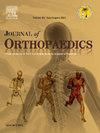Greater preoperative expectations predict improvement in pain and function two years after knee surgery
IF 1.5
Q3 ORTHOPEDICS
引用次数: 0
Abstract
Introduction
Higher preoperative patient expectations correlate with better early postoperative outcomes and satisfaction after orthopaedic surgery. However, it is unclear if this association is maintained past one year after knee surgery. It was hypothesized that greater preoperative expectations would be predictive of better patient-reported pain and function two years after knee surgery.
Materials and methods
460 patients undergoing knee surgery between June 2015 and April 2018 were reviewed retrospectively. Baseline and two-year follow-up questionnaires were administered consisting of six Patient-Reported Outcomes Measurement Information System (PROMIS) computer adaptive testing domains, the International Knee Documentation Committee (IKDC) score, a numeric pain scale (NPS), the Tegner Activity Scale (TAS), and the Marx Activity Rating Scale (MARS). Preoperative expectations were measured using the Musculoskeletal Outcomes and Data Evaluation Management System (MODEMS) preoperative expectations domain, and satisfaction was measured via the Surgical Satisfaction Questionnaire (SSQ-8). Statistical analysis was performed to identify associations between preoperative expectations and patient-reported outcomes at two years postoperatively.
Results
The mean (SD) preoperative expectations score was 91.0 (17.9). Greater preoperative expectations were associated with various demographic factors as well as baseline PROMIS Social Satisfaction, NPS body, and MARS lower extremity scores. Greater preoperative expectations were associated with both significantly better two-year and improvement in PROMIS Physical Function, PROMIS Pain Interference, and IKDC. Additionally, greater preoperative expectations were associated with better two-year PROMIS Fatigue, PROMIS Anxiety, whole body NPS, and Met Expectations, as well as greater improvement in PROMIS Social Satisfaction. Multivariable analysis found that greater preoperative expectations were predictive of improvement in PROMIS Pain Interference and IKDC.
Conclusion
Greater preoperative expectations are independently predictive of improvement in pain and function two years after knee surgery. The impact of patient expectations on outcomes after knee surgery appear to be long-lasting; therefore, optimization of expectations prior to surgery may help maximize postoperative outcomes.
求助全文
约1分钟内获得全文
求助全文
来源期刊

Journal of orthopaedics
ORTHOPEDICS-
CiteScore
3.50
自引率
6.70%
发文量
202
审稿时长
56 days
期刊介绍:
Journal of Orthopaedics aims to be a leading journal in orthopaedics and contribute towards the improvement of quality of orthopedic health care. The journal publishes original research work and review articles related to different aspects of orthopaedics including Arthroplasty, Arthroscopy, Sports Medicine, Trauma, Spine and Spinal deformities, Pediatric orthopaedics, limb reconstruction procedures, hand surgery, and orthopaedic oncology. It also publishes articles on continuing education, health-related information, case reports and letters to the editor. It is requested to note that the journal has an international readership and all submissions should be aimed at specifying something about the setting in which the work was conducted. Authors must also provide any specific reasons for the research and also provide an elaborate description of the results.
 求助内容:
求助内容: 应助结果提醒方式:
应助结果提醒方式:


